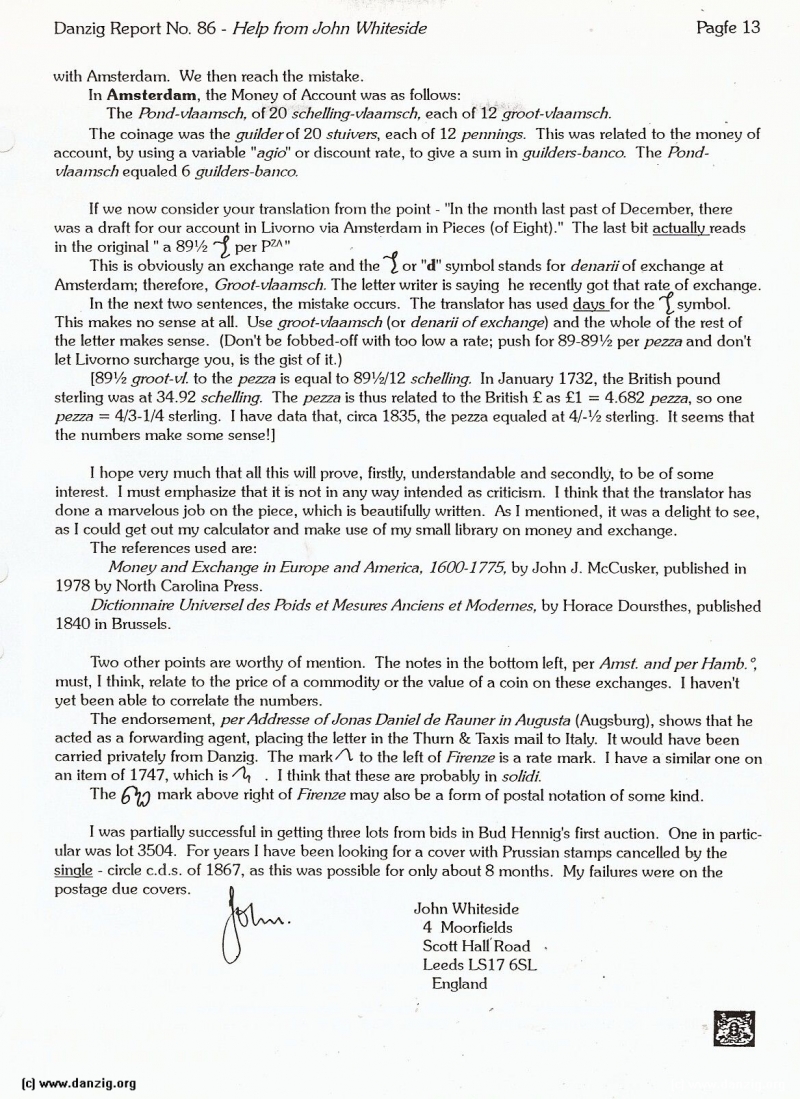
with Amsterdam. We then reach the mistake.
In Amsterdam, the Money of Account was as follows:
The Pond-vlaamsch, of 20 schelling-vlaamsch, each of 12 gmot-vlaamsch. –
The coinage was the guiIderof 20 stuiver, each of 12 pennigs. This was related to the money of account, by using a variable “agid or discount rate, to give a sum in guildeis-banco. The Pond vlaainsch equaled 6 guildes-banco.
If we now consider your translation froni (lie point - “In the month last past of December, there was a draft for our account in Livorno via Amsterdam in Pieces (of Eight).” The last bit actually reads in the original “ a 89½ ‘ per Pza
This is obviously an exchange rate and the or “d” symbol stands for denarllof exchange at Amsterdam; therefore, Groot-vlaarnsch. The letter writer is saying he recently got that rate of exchange.
In the next two sentences, the mistake occurs. The translator has used days for the symbol. This makes no sense at all. Use groot-vlaamsch (or denaril of exchange) and the whole of the rest of the letter makes sense. (Don’t be fobbed-off with too low a rate; push for 89-89½ per pezza and don’t let Livorno surcharge you, is the gist of it.)
[89½ groot-vI. to the pezza is equal to 89W12 schellnig. In January 1732, the British pound sterling was at 34.92 schelling. The pezza is thus related to the British £ as £1 = 4.682 pezza, so one pezza = 4/3-1/4 sterling. I have data that, circa 1835, the pezza equaled at 4/-½ sterling. It seems that the numbers make some sense!]
I hope very much that all this will prove, firstly, understandable and secondly, to be of some interest. I must emphasize that it is not in any way intended as criticism. I think that the translator has done a marvelous job on the piece, which is beautifully written. As I mentioned, it was a delight to see, as I could get out my calculator and make use of my small library on money and exchange.
The references used are:
Money and Exchange in Europe and America, 1600-1775, by John J. McCusker, published in 1978 by North Carolina Press. Dictionnaire Univeiseldes Poids etMesumsAnc/ens etModernes, by Horace Doursthes, published 1840 in Brussels.
Two other points are worthy of mention. The notes in the bottom left, per Amst. and per Hainb. °, must, I think, relate to the price of a commodity or the value of a coin on these exchanges. I haven’t yet been able to correlate the numbers.
The endorsement, per Addresse of Jonas Daiiiel de Rauner in Augusta (Augsburg), shows that he acted as a forwarding agent, placing the letter in the Thurn & Taxis mail to Italy. It would have been carried privately from Danzig. The mark-I. to the left of Firenze is a rate mark. I have a similar one on an item of 1747, which is . I think that these are probably in solidi.
The mark above right of Firenze may also be a form of postal notation of some kind.
I was partially successful in getting three lots from bids in Bud Hennig’s first auction. One in particu lar was lot 3504. For years I have been looking for a cover with Prussian stamps cancelled by the single - circle c.d.s. of 1867, as this was possible for only about 8 months. My failures were on the postage due covers.
John Whiteside
4 Moorfields
Scott Hall Road
Leeds L517 6SL
England
Danzig Report Nr. 86 - January - February - March - 1995, Page 13.
Hits: 3592
Added: 10/07/2015
Copyright: 2025 Danzig.org

